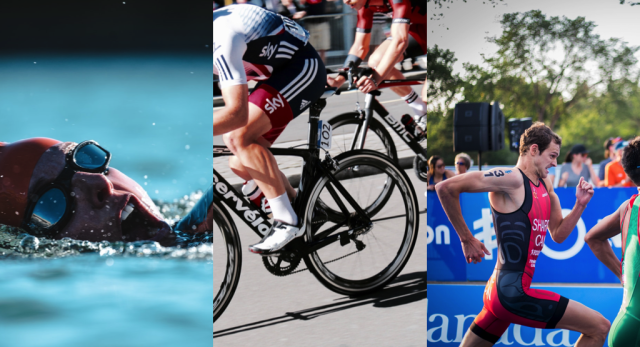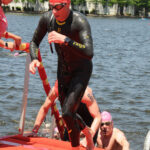In the first article in my three-part series exploring the impact of intensity on triathlon training and racing, I introduced you to what intensity is, how it affects you, how you can tell when you are either under- or over-intense. This article will focus on how you can identify your ideal intensity for triathlon and how different parts of a race and even different distances may require different levels of intensity.
Your intensity is much like the thermostat maintaining the most comfortable temperature in your house. You always notice when your house is too warm or too cold because you’re sensitive to changes in temperature. When the temperature becomes uncomfortable, either too high or too low, you adjust the thermostat to a more comfortable level. You can think of your intensity as your internal temperature that needs to be adjusted periodically. You need to be sensitive to when your intensity is no longer comfortable, in other words, you are too relaxed or too anxious, and it’s not allowing you to perform your best. You can then use the psych-up and psych-down exercises I’ll be describing in the final part of my three-part series to raise or lower your intensity to its prime level.

You have several goals in developing prime intensity. First, to learn what is your prime intensity. Then, to recognize the signs of overintensity and underintensity in training and races. Next, to identify those situations in which your intensity may go up or down. Finally, to take active steps to reach and maintain prime intensity throughout training and races.
Determining Your Prime Intensity
The first step in taking control of your intensity is to identify what is your prime intensity. You can garner information in two ways to make this determination. First, think back to several races in which you performed very well. Recall your level of intensity. Were you relaxed, energized, or really fired up? Then remember the thoughts, emotions, and physical feelings you experienced during these races. Were you positive or negative, happy or angry, relaxed or tense? Second, think back to several races in which you performed poorly. Recall your level of intensity. Remember the thoughts, emotions, and physical feelings you had in these races. If you’re like most triathletes, a distinct pattern will emerge. When you perform well, you have a particular level of intensity. This is your prime intensity. There are also common thoughts, emotions, and physical feelings associated with your prime intensity and performing well. In contrast, when you’re performing poorly, there is a very different level of intensity, either higher or lower than your prime intensity. There are also decidedly different thoughts, emotions, and physical feelings.

Second, you can experiment with different levels of intensity in training and see how the differing intensity impacts your performances. Here is a good exercise you can use to learn more about your prime intensity:
Let’s say you’re engaging in an interval workout either swimming (6x100y), biking (6x1m), or running (6x200y). Break up your workout into three segments of two intervals each. The first segment will emphasize low intensity. Before you begin the intervals, take several slow, deep breaths, relax your muscles, and focus on calming thoughts (e.g., “Easy does it,” “Cool and calm.”). As you begin the intervals, stay focused on keeping your body relaxed and calm.

The second segment will focus on moderate intensity. Before the intervals, take a few deep, but more forced breaths, move your body a bit, and focus on more energetic thoughts (e.g., “Let’s go,” “Pick it up.”). Before the intervals, move your body with more energy and feel your intensity picking up. During the intervals, pay attention to feeling the intensity and energy in your body.
The final segment will highlight high intensity. Before the intervals, take several more intense breaths with special emphasis on a hard and aggressive exhale, start bouncing up and down more actively, and repeat intense thoughts (e.g., “Fire it up,” “Get after it.”), saying these out loud with energy and force. Feel the high level of intensity and energy as you begin the intervals, and focus on maintaining that intensity with high-energy self-talk and intense breathing.
You can also use this exercise with longer duration workouts and see its impact on your efforts.
I encourage you to do this for several days so you can see clearly how your intensity impacts your performance. As with comparing past good and poor competitive performances, you will likely see a pattern emerge in which you perform better at one of the three levels of intensity and you will likely see the same level of intensity that you identified in past races as being related to good performance. That level of intensity, your prime intensity, is the one you want to aim for in both training and races.

With this knowledge, you will have a good sense of your prime intensity. You can then use that information to recognize when you’re not at prime intensity and you need to adjust your intensity to a prime level both before and during training and races.
In my final article in this three-part series, I’ll share with you practical tools you can use to gain control of your intensity and raise or lower it to its ideal level.
Do you want to take the next step in training your mind to perform your best in training and on race day? Here are four options for you:
- Read my latest mental training book: Train Your Mind for Athletic Success: Mental Preparation to Achieve Your Sports Goals.
- Listen to my Train Your Mind for Athletic Success podcast.
- Take a look at myonline mental training courses.
- Schedule a 1:1 session with me.







